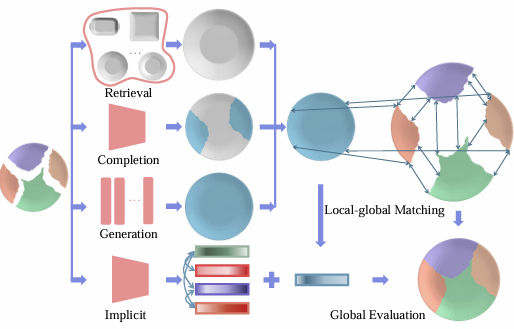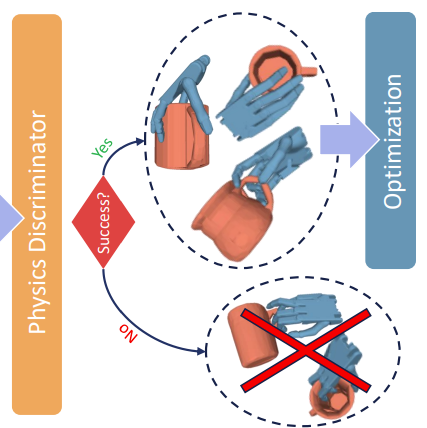Qixing Huang
Generalized 3D Reassembly
|
Reconstructing a complete object from its parts is a fundamental problem in many scientific domains. In archaeology, we collect fragments of one or multiple objects at an archaeological site, and the goal is to restore the original objects. In medical applications, we need to study how to assemble bone fragments to plan bone reduction surgery. This problem is also crucial in paleontology for reconstructing fossils and in forensics for evidence reconstruction. The challenge extends to 3D object/scene modeling, where we want to construct a complete object/scene from parts/objects. Other relevant problems are protein docking and human-object interactions, in which the difference is that the transformation of each part becomes non-rigid. In a recent survey article [EGSTAR25], we have provided a comprehensive review of this research area, including various applications. I started working on this problem at an early stage of my career. In [SIG06], I developped one of the first complete fractured object reassembly system. Over the years, I worked on a real project [JOCCH09] in Emphsus, Turkey, reassembling bone fragments [CG23]. My recent work along this line includes JIGSAW [NEURIPS23], which employs deep neural networks to solve the reassembly problem. Along a relevant line [ECCV24], I looked into how to predict the interaction between hands and 3D objects, supporting three correlated tasks (i.e., grasp generation, object generation from hand poses, and joint hand-pose and 3D object generation). |
|
[EGSTAR25] Jiaxin Lu, Yongqing Liang, Huijun Han, Jiacheng Hua, Junfeng Jiang, Xin Li and Qixing Huang. A Survey on Computational Solutions for Reconstructing Complete Objects by Reassembling Their Fractured Parts. Eurographics 2025 State-of-the-Art Report (Special Issue of Computer Graphics Forum) |
|
[ECCV24] Jiaxin Lu, Hao Kang, Haoxiang Li, Bo Liu, Yiding Yang, Qixing Huang and Gang Hua. UGG: Unified Generative Grasping. European Conference on Computer Vision (ECCV) 2024 |
|
[NEURIPS23] Jiaxin Lu, Yifan Sun and Qixing Huang. Jigsaw: Learning to Assemble Multiple Fractured Objects. Thirty-seventh Conference on Neural Information Processing Systems (NeurIPS) 2023. |
|
[CG23] Ziyue Deng, Junfeng Jiang, Zhengming Chen, Wenxi Zhang, Qingqiang Yao, Chen Song, Yifan Sun, Zhenpei Yang, Siming Yan, Qixing Huang and Chandrajit Bajaj. TAssembly: Data-driven Fractured Object Assembly Using a Linear Template Model. Computers & Graphics, Computers & Graphics,Volume 113, June 2023, Pages 102-112 |
|
[JOCCH09]Barbara Thuswaldner, Simon Flory, Robert Kalasek, Michael Hofer, Qixing Huang, and Hilke Thur. Digital Anastylosis of the Octagon in Ephesos. Journal on Computing and Cultural Heritage 2(1), 2009. |
|
[SIG06]Qixing Huang. Simon Fl#246ry, Nathsha Gelfand, Michael Hofer, and Helmut Pottmann. Reassembling Fractured Objects by Geometric Matching. ACM Transactions on Graphics 25(3) (Proc. SIGGRAPH 2006). |





